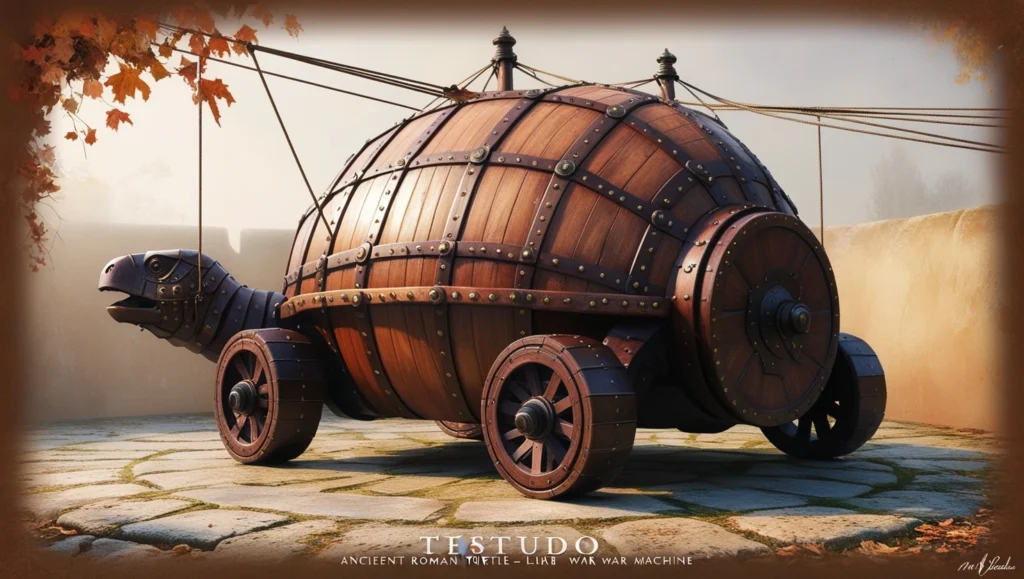Introduction to Testudo
The term “Testudo,” which means “tortoise” in Latin, refers to one of the most iconic military formations of ancient Rome. Known for its strength and ability to shield soldiers from attacks, this formation became a critical asset in warfare. The Testudo offered unique protection in open battles, sieges, and other challenging combat situations. But what exactly is the Testudo, and why did it leave such a lasting impact?
What is the Testudo Formation?
The Testudo formation, aptly named after the hard-shell tortoise, was a shield-based arrangement that Roman soldiers used for protection against enemies. By interlocking shields overhead and around the sides, soldiers created a nearly impenetrable wall to deflect arrows, rocks, and other projectiles. This formidable defense mechanism was integral to the Romans’ military success and illustrated their strategic and tactical ingenuity.
Origins of the Testudo Formation
The Testudo formation traces its origins back to the early Roman Republic, but it became especially prominent during the Roman Empire. This method allowed soldiers to approach fortified positions with relative safety, keeping them safe from aerial attacks. This approach was inspired by the need to improve troop survivability and efficiency in various combat scenarios.
How the Testudo Formation Worked
The Testudo worked by aligning soldiers in close proximity, where each soldier’s shield was connected with the shields of others. By creating a wall around the soldiers and a roof overhead, the formation protected them from projectiles and allowed them to advance on enemy positions.
Basic Structure of the Formation
Typically, soldiers in the front row held their shields in front to protect from frontal attacks, while those in the middle and back rows held shields overhead. The design required extreme discipline and coordination, as any gaps in the formation would make it vulnerable.
The Role of Shields in the Testudo
Shields were essential to the Testudo’s success. The rectangular Roman shield, known as the scutum, was large enough to cover most of the soldier’s body. When interlocked, these shields formed an unbroken barrier, protecting soldiers from arrows, rocks, and even boiling liquids in some cases.
Shield Design and Protection
The design of the Roman shield, with its curved shape and substantial size, allowed it to cover the bearer and contribute to the protective layer around the formation. Made of wood, leather, and metal, the scutum was durable and relatively lightweight, providing excellent protection and mobility.
Execution of the Testudo Formation
The Testudo required rigorous training, as soldiers needed to coordinate every movement with precision. Each soldier’s role was crucial, and even slight mistakes could jeopardize the entire formation. Roman soldiers trained extensively to ensure flawless execution in battle, a key reason for their success in numerous conflicts.
Types of Testudo Formations
While the basic structure of the Testudo remained the same, variations were developed to suit different situations. Some adaptations were tighter, offering increased protection, while others allowed for more flexibility and mobility. These variations illustrate the versatility of the Testudo, enabling soldiers to adapt to various combat scenarios.
Adaptations for Different Situations
For example, in siege warfare, the Testudo was often reinforced to withstand heavier attacks. In open-field battles, a looser Testudo formation allowed for quicker movements while still offering significant protection.
Advantages of the Testudo Formation
The Testudo provided Roman soldiers with several distinct advantages:
- Protection: Soldiers were shielded from projectiles, allowing them to approach fortified positions safely.
- Coordination: The formation promoted teamwork and unity among troops, enhancing their combat efficiency.
- Psychological Impact: The sight of an advancing Testudo could intimidate enemies, showcasing the Roman army’s discipline and coordination.
Challenges and Limitations of the Testudo Formation
Despite its effectiveness, the Testudo had limitations. Movement within the formation was slow, making it difficult to maneuver quickly in open combat. Additionally, it required significant energy and discipline to maintain, which could be draining for soldiers during prolonged engagements.
Significance in Historical Battles
The Testudo was notably used in famous Roman battles, such as the Siege of Alesia and the Siege of Jerusalem. In these encounters, the formation allowed Roman forces to protect themselves while advancing under heavy fire, ultimately leading to victory in many cases.
Famous Battles Using the Testudo
In the Siege of Jerusalem (70 AD), Roman soldiers used the Testudo to approach and scale walls while withstanding intense attacks. Their disciplined use of this formation contributed significantly to the Roman victory.
Why the Testudo Formation Declined
Over time, as warfare evolved, the Testudo formation became less practical. The emergence of new weaponry and tactics, such as long-range artillery and more mobile combat styles, diminished the effectiveness of a tightly-packed shield wall. Eventually, the formation was phased out in favor of more adaptable strategies.
Influence of Testudo in Modern Military Tactics
While no longer in use, the Testudo has influenced modern military tactics that emphasize group coordination, protective positioning, and the use of barriers. Similar shield formations are seen in riot control units, where police use shields to protect against projectiles.
Testudo as a Symbol in Modern Culture
Today, the Testudo is more than just a military formation. Its symbolism of unity, strength, and resilience is widely recognized. This legacy endures in various cultural symbols, educational institutions, and sports teams.
The Testudo in University of Maryland Mascot
Interestingly, the University of Maryland adopted the Testudo as its mascot, a diamondback terrapin turtle. The mascot represents determination and resilience, much like the original Roman formation. It serves as a symbol of the school’s spirit, with the “Testudo” embodying the unity and protective strength associated with the Roman Testudo formation.
How Testudo Represents Team Spirit
The Testudo mascot stands as a representation of the school’s values. Just as Roman soldiers worked together within the Testudo formation, students and athletes at the University of Maryland work collaboratively to achieve success.
Conclusion
The Testudo formation is a fascinating chapter in military history, showcasing the ingenuity and discipline of the Roman army. Although no longer in use, its influence is evident in modern culture and tactics. This formation not only protected soldiers but also instilled a sense of unity that resonates with people to this day. The Testudo remains a symbol of resilience, strength, and teamwork.
Also Read this Article india national cricket team vs zimbabwe national cricket team match scorecard



